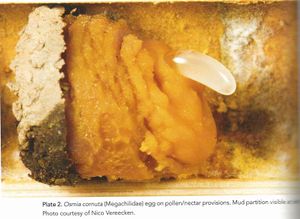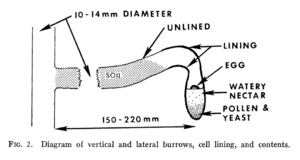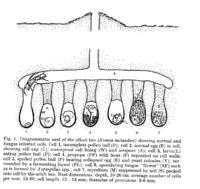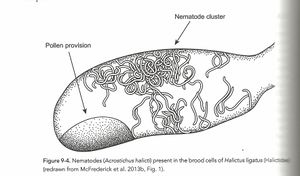Brood Cell Microcosm

The nests of solitary wasp species (including everybody's favorite pollen-collecting solitary wasps "the bees") are known as brood cells. Depending on the species observed these cells can be found in underground chambers, hollow twigs, sculpted with mud, or even crammed inside abandoned snail shells. These cells that female wasps provision with a food source (prey or pollen) and lay an egg in, don't stop interacting with the environment once they are sealed. The microcosm formed when a mother wasp seals a finished brood cell is home to a plethora of co-evolved relationships that can beneficially or negatively affect the health of the egg/larvae found in the nest. Brood cell mutualists and parasites span across many taxa; from yeasts and bacteria that negatively affect the health of the occupant, all of the way to mutualistic prostigmatic mites that fend off/eat infectious fungi.[3]
Solitary Wasp Life Cycle and Development:
Solitary wasps are any of the Aculeate Hymenoptera that are not social, meaning they don't have a reproductive division of labor with queens laying eggs and workers working. Instead, female individuals create their own nests (broods) and provision these nests with a food source on their own. The food sources that each species of solitary wasps collect are highly variable. Some individual species or groups of closely related species can be extremely specialized to one type of food item. Examples of this are the clade Anthophila (the bees) which all provision their brood cells exclusively with pollen, or the family Pompilidae (the spider wasps) which only provision their nests with spiders, to extreme cases like in Bicyrtes quadrifasciatus or the "Stink bug" hunter that exclusively collects prey from the true bug family Pentatomidae. Once a brood cell is provisioned to perfection the solitary wasp mother will lay a single egg and seal the cell. She will build and provision brood cells until she dies. The eggs laid will hatch into larvae and begin to eat the food provision and grow. Larvae of many species undergo a period of diapause during the winter months before they pupate and exit as adults in the spring/summer. The focus of this page will take place in the part of the life cycle after the mother wasp seals her preciously provisioned cell and before her offspring emerges the following year. [3]
Members of Brood Cell Microcosm:
This section is a brief window into the understudied diversity of the solitary bee brood cell. There are many non-bee solitary wasp brood cell associates but most research has been focused on the economically important bee species.
Bacteria:
Most studies of microbial associates living inside the food provision of wasp brood cells come from work done on the non-solitary bee species such as honey or bumblebees. Early research was done using culture-based techniques by Gilliam et al. in 1984 and 1989 that demonstrated spore-forming bacteria in the genus Baccilus are not only found in the pollen provisions of social honeybee and bumblebee colonies, but also in 3 species of solitary bees spanning across 2 different families (Apidae and Colletidae). This genus of bacteria is known to produce enzymes that are used by honey bees as microbial agents in their pollen and nectar provisions. Gilliam states: "The production of both antibiotics and fatty acids by Bacillus spp. in larval provisions could limit the types of microbes that are able to survive, inhibit competition by other microbes for this food source, and protect the food from spoilage." [4]
Recent work using modern techniques such as metagenomic sequencing has revealed other bacterial species such as Burkolderia sp. ubiquitously inhabit the midgut of most bee families and some families of the closely related apoid wasps. This bacteria may be an important member of the digestive tract microbiota of solitary bee and wasp species and may be transferred into pollen provisions that are eaten by larvae. [3]
Other species of bacteria such as the American and European foulbrood ( Paenicacillus larvae and Melissococcus plutonius respectively) cause serious disease in honeybees colonies. Bacterial-borne pathogens that affect wild solitary bees are largely unknown and need to be researched with more depth. [3]
More research is needed on all fronts to determine the microbial diversity associated with brood cells to determine what roles they play in solitary bee and wasp community ecology.
Fungi and Yeasts:
Studies have shown that there are a diversity of fungi and yeasts that play important beneficial, negative, and possibly commensal roles in the microcosm of solitary bee and wasp brood cells. Here we will review the potential mutualistic and pathogenic fungi and yeasts associated with bee and wasp brood cells. [3]
Mutualists

In Roberts' 1971 review of the crepuscular bee species, Ptiloglossa guinnae in the family Colletidae (notable for their liquid pollen provisions) stated that almost "each of the more than one hundred brood cells examined was actively fermenting. The odor of fermentation was unmistakable and bubbles of gas could be seen rising from the ropey slime at the bottom of each cell". This ropey slime was later cultured and found to be two species of yeast, Saccharomyces sp. and Candida pulcherrima. Roberts notes the cells contained so little pollen and so much yeast that it seemed that much of the nutrients for the developing larvae of P. guinnae were gained from the yeasts as opposed to the pollen collected. He therefore then postulates yeasts have gained a mutualistic relationship with Ptiloglossa sp. [6]
Other bees that provision their nests with a liquid provision such as members of the subfamilies Hylaeinae, Diphaglossinae, Oxaeinae, and the tribe Eucerini also have anecdotal evidence of yeast mutualists through researchers taking note of a fermenting smell when processing their brood cells. [3]
More research is needed to investigate the role that yeast mutualists play in the development of larvae in solitary bee lineages that provision their brood cells with liquid nectar and pollen. Evidence of species of bees that have switched from pollen-collecting to yeast-farming (or fungal farming) is not improbable and has yet to be discovered.
Pathogens

The same beneficial yeasts described above can also negatively affect other lineages of bees (mostly species with non-liquid provisions). Batra et al (1973) provide a detailed examination of larval mortality in Nomia melanderi caused by a microbial succession triggered by yeasts (such as Saccharomyces, Pichia, Hansenula etc.) and ending with secondary fungal invaders (such as Aspergillus, Penicillium, and Ascosphaera). Figure 1 from this paper, pictured to the right, shows the process of the normal developmental track of N. melanderi v.s one that has been infected with the fungal progression of an Aspergillus sp. The Aspergillus fungi are also known to infect and cause mortality of larvae of other species of bee such as Diadasia biturberculata and Ptilothrix sp. [1]
Another species of fungi known to significantly increase mortality of bee larvae are members of the genera Ascosphaera. There are 29 known members of this genus that have obligate associations with solitary and social bee brood cells. Some species of this fungi are known to be pathogenic to their host bees. A disease known as "chalkbrood" is caused by members of Ascosphaera and leads to death in solitary bees that are infected. [3]
Other species of fungal associates of brood cells can be found complied in charts in Batra et al's 1973 "Mycoflora of Domesticated and Wild Bee Species (Apoidea)". It is important to note that the total fungal diversity that inhabits brood cells is most likely much larger than just those recorded from the species of bee observed in this study. More work needs to be done in order to classify the extent of fungal diversity found in solitary bee and wasp brood cells. [1]
Nematodes:

In-nest nematodes are an extremely understudied, and therefore, poorly understood group of solitary bee and wasp associates. These nematodes can be found inhabiting the reproductive tracts and brood cells of bees across all but one family (the Australian continent restricted Stenotritidae). Nematode genera known to live inside bees and their brood cells are: Arcostiphelenchus, Aduncospiculum, Bursaphelenchus, Aphelenchoides, and Koerneria. There are likely others to be discovered. Surprisingly, studies like McFredrick et al. (2013) "Evolution of conflict and cooperation of nematodes associated with solitary and social sweat bees" show that many of these nematodes are commensal and have no effects on the reproduction/ survival of their solitary bee hosts. [3]
Most species of bee-inhabiting nematode follow a life history trajectory similar to species in the genera Acrostichus. Species in this genus of nematode inhabit the reproductive tract of social and solitary bees in the family Halictidae. Transmission of nematodes between hosts is mostly done vertically. This means that nematodes are passed through individuals from mother to daughter or son. Transmission also happens less frequently through sexual reproduction, in this case, male bees transport the resting stage of the nematode called the "dauer" to the female through reproduction. Once the dauers are in females they congregate in the dufours gland, where they are secreted onto the walls a brood cell as the female is building her nest. They will then grow and reproduce as "non-dauer" adults in the brood cell (pictured to the right) and once the host bee completes its development and molts into adulthood, juvenile nematodes will enter the freshly hatched female bees dufour gland or males genitalia to start their life cycle over again. [3]
Mites:
A section on the in-nest mite associates of solitary bees and wasps is needed for this page.
Citations
1. Batra, L. R., S. W. T. Batra, and G. E. Bohart. 1973. The mycoflora of domesticated and wild bees (Apoidea). Mycopathologia et Mycologia Applicata 49:13–44.
2. Cane, J. H., S. Gerdin, and G. Wife. 1983. Mandibular Gland Secretions of Solitary Bees (Hymenoptera: Apoidea): Potential for Nest Cell Disinfection. Journal of the Kansas Entomological Society 56:199–204.
3. Danforth, B. N., R. L. Minckley, J. L. Neff, and F. Fawcett. 2019. The Solitary Bees: Biology, Evolution, Conservation. Princeton University Press.
4. Gilliam, M., S. L. Buchmann, and B. J. Lorenz. 1984. MICROBIAL FLORA OF THE LARVAL PROVISIONS OF THE SOLITARY BEES, CENTRIS PALLIDA AND ANTHOPHORA SP. Apidologie 15:1–10.
5. McFrederick, Q. S., and D. R. Taylor. 2013. Evolutionary history of nematodes associated with sweat bees. Molecular Phylogenetics and Evolution 66:847–856.work(s):,
6 R. B. R. R. 1971. Biology of the Crepuscular Bee Ptiloglossa guinnae N. Sp. with Notes on Associated Bees, Mites, and Yeasts. Journal of the Kansas Entomological Society 44:283–294.